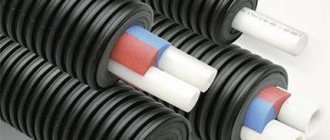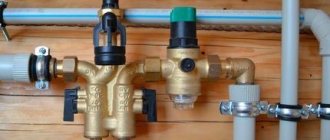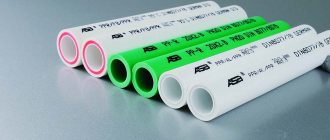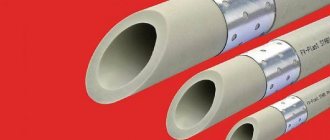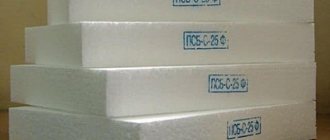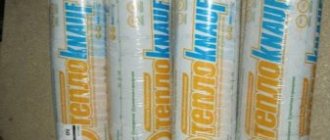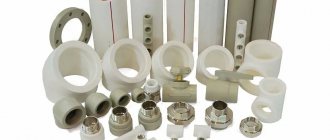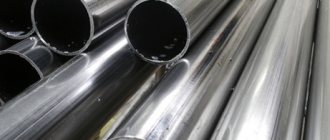A wide selection of communication systems for water supply and heating allows you to select a material that meets the range of technical requirements for heating and water supply. Pipes, connections, valve fittings are adapted for routes of various lengths, operating from different coolant systems. But polypropylene pipes for heating remain the most popular. They owe this to their quality characteristics and affordable price. Another undeniable advantage of polypropylene pipes is ease of installation.
Assorted propylene pipes
What properties do different types of polypropylene pipes have?
Polypropylene is a thermoplastic synthetic non-polar polymer. The polymerization method using a Ziegler-Natta catalyst was invented in 1957, and since then the production of products with an isotactic structure characterized by high strength
, heat resistance and a high degree of crystallinity.
Polypropylene is a material that is resistant to acid, alkaline and saline solutions, as well as other inorganic substances. It does not absorb liquid and retains its electrical insulating properties over a wide range of temperatures.
Based on polypropylene, various modified materials are produced, such as thermoplastic, high-strength plastic and other environmentally friendly products. Recycling and recycling are a technological process, due to which polypropylene is actively displacing products made from other types of plastics from the world market.
Polypropylene melts at a temperature of +164…+170 °C
, Brinell hardness ranges from 40 to 70 MPa, brittleness temperature - from
-10 to -15 ° C
, tensile failure stress (kgf/cm2) - from 250 to 400, flexural modulus of elasticity (kgf) - from 6700 to 11900 .
A huge number of products that are popular on the market today are made on the basis of sheet propylene. To produce this material, the extrusion method is used. Depending on the shade, smoothness and other factors, sheets are divided into two classes. They are used for the production of pipeline systems, connecting them together in different ways, one of which is welding.
Specifications
Technical characteristics of polypropylene pipes:
- Frost resistance indicator - up to -15 degrees. Pipes made from this material are not suitable for the manufacture of external water pipes.
- Low thermal conductivity. Thanks to this, the liquid reaches from one end of the pipeline to the other with a minimum temperature difference.
- The density of polypropylene is 0.91 kg/cm2.
- Chemical resistance of the material.
- High linear expansion rate.
- Mechanical strength - 35 N/mm.
- Softening of polypropylene begins at 140 degrees.
- Heat resistance to coolants - up to 120 degrees.
- Plastic melting starts at 170 degrees.
- The operating pressure range is 10–25 atmospheres.
Pipes from this material are made with diameters from 10 to 125 mm. The parts are connected using a special soldering iron. Thanks to soldering, a strong, airtight seam is obtained.
When installing polypropylene pipes, it is important to take into account its high linear expansion. When connecting household appliances and radiators, special compensators must be installed.
Types of polypropylene pipes
Polypropylene (accepted international designation - PP) has been used for quite a long time for the manufacture of pipes as a base material. However, only the development of modern technologies has made it possible to obtain products that can be used for hot water supply and heating systems.
Polypropylene itself is characterized by its pronounced inertness to the chemical effects of a possible liquid coolant medium. However, in terms of heat resistance and strength, different types can differ significantly from each other.
So, pipes made of this material are divided into three main types, which have their own designations:
PP-N are intended for cold water only
- PP-N is the first type of polypropylene pipes, inert to chemical influences, but not resistant to elevated temperatures. Therefore, they are intended for cold water supply, sewerage, drainage systems, ventilation and other applications where elevated temperatures are not expected. Very often, this type of pipe is prevalent for industrial production lines, as it is highly resistant to increased internal pressure.
The range of possible applications of PP-V pipes is somewhat wider, but for heating they are still “weak”
- PP-B is the second type of polypropylene pipes, which has all the same advantages of PP-N, but, in addition, has the ability to withstand temperature loads of low amplitude. Therefore, they can be installed on separate main sections of “warm floor” systems. And also in hot water supply circuits, provided that the water or coolant does not heat above 50 degrees.
However, the main scope of application of PP-B is different. Most often, such pipes are used for sewer systems, since the material from which they are made has a sufficient degree of impact strength and heat resistance for this area.
Only PPR pipes are fully suitable for heating systems
- PPRC, PPR or PP-3 is the most advanced type of pipes that is used in hot water supply and heating systems, that is, where temperatures can exceed 50 degrees and there is a possibility of increased compression loads. Increased heat resistance and mechanical strength are achieved thanks to special production technologies, in which ethylene molecules are introduced into the molecular lattice of propylene during synthesis.
PPR are pipes that are most widely used in domestic conditions, as they have a pronounced resistance to internal pressure and temperature changes.
Polypropylene pipes (PPR), used in domestic conditions, in turn, are divided into several types, depending on resistance to baric loads: PN -25; PN -20; PN -16; PN -10. Their main characteristics are given in the table:
| Type of polypropylene pipes | Nominal working pressure | Scope of pipe use | |
| MPa | technical atmospheres (kgf/s²) | ||
| PN-10 | 1 | 10.21 | Connection to the “warm floor” circuit, the coolant in the system of which has a temperature of no higher than 45 ° C, or cold water supply. This type of pipe is designed for a system pressure of no more than 1 MPa. It is the most affordable due to its rather low performance characteristics. |
| PN-16 | 1.6 | 16.32 | Cold and hot water supply with a temperature of no more than 60˚C and a pressure of no more than 1.6 MPa. |
| PN-20 | 2 | 20.40 | Cold and hot water supply in an autonomous system with low pressure and no water hammer. The coolant temperature for this type of product should not exceed 80˚C, and the pressure should not exceed 2.0 MPa. |
| PN-25 | 2.5 | 25.49 | Hot water supply and heating with coolant up to 90÷95˚С, including in the central heating system. The pressure for which they are designed is 2.5 MPa. |
Each type of pipe is produced in a fairly wide range of diameters, internal and external: on which the wall thickness depends
| Outer diameter, mm | PN-10 | PN-16 | PN-20 | PN-25 | ||||
| Internal Ø, mm | Wall thickness, mm | Internal Ø, mm | Wall thickness, mm | Internal Ø, mm | Wall thickness, mm | Internal Ø, mm | Wall thickness, mm | |
| 16 | — | — | 11.6 | 2.2 | 10.6 | 2.7 | — | — |
| 20 | 16.2 | 1.9 | 14.4 | 2.8 | 13.2 | 3.4 | 13.2 | 3.4 |
| 25 | 20.4 | 2.3 | 18 | 3.5 | 16.6 | 4.2 | 16.6 | 4.2 |
| 32 | 26 | 3 | 23 | 4.4 | 21.2 | 5.4 | 21.2 | 3 |
| 40 | 32.6 | 3.7 | 28.8 | 5.5 | 26.6 | 6.7 | 26.6 | 3.7 |
| 50 | 40.8 | 4.6 | 36.2 | 6.9 | 33.2 | 8.4 | 33.2 | 4.6 |
| 63 | 51.4 | 5.8 | 45.6 | 8.4 | 42 | 10.5 | 42 | 5.8 |
| 75 | 61.2 | 6.9 | 54.2 | 10.3 | 50 | 12.5 | 50 | 6.9 |
| 90 | 73.6 | 8.2 | 65 | 12.3 | 60 | 15 | — | — |
| 110 | 90 | 10 | 79.6 | 15.1 | 73.2 | 18.4 | — | — |
Naturally, the values of diameters and wall thicknesses directly affect the resistance of pipes to temperature and pressure, which, in principle, determines the duration of their possible operation in certain conditions:
| Coolant temperature ˚С | Service life, years | Pipe type | |||
| PN-10 | PN-16 | PN-20 | PN-25 | ||
| Permissible excess pressure (kgf/cm²) | |||||
| 20 | 10 | 13.5 | 21.7 | 21.7 | 33.9 |
| 25 | 13.2 | 21.1 | 26.4 | 33 | |
| 50 | 12.9 | 20.7 | 25.9 | 32.3 | |
| 30 | 10 | 11.7 | 18.8 | 23.5 | 9.3 |
| 25 | 11.3 | 18.1 | 22.7 | 28.3 | |
| 50 | 11.1 | 17.7 | 22.1 | 27.7 | |
| 40 | 10 | 10.1 | 16.2 | 20.3 | 25.3 |
| 25 | 9.7 | 15.6 | 19.5 | 24.3 | |
| 50 | 9.2 | 14.7 | 18.4 | 23 | |
| 50 | 10 | 13.9 | 17.3 | 23.5 | 21.7 |
| 25 | 8 | 12.8 | 16 | 20 | |
| 50 | 7.3 | 11.7 | 14.7 | 18.3 | |
| 60 | 10 | 7.2 | 11.5 | 14.4 | 18 |
| 25 | 6.1 | 9.8 | 12.3 | 15.3 | |
| 50 | 5.5 | 8.7 | 10.9 | 13.7 | |
| 70 | 10 | 5.3 | 8.5 | 10.7 | 13.3 |
| 25 | 4.5 | 7.3 | 9.1 | 11.9 | |
| 30 | 4.4 | 7 | 8.8 | 11 | |
| 50 | 4.3 | 6.8 | 8.5 | 10.7 | |
| 80 | 5 | 4.3 | 6.9 | 8.7 | 10.8 |
| 10 | 3.9 | 6.3 | 7.9 | 9.8 | |
| 25 | 3.7 | 5.9 | 7.5 | 9.2 | |
| 95 | 1 | 3.9 | 6.7 | 7.6 | 8.5 |
| 5 | 2.8 | 4.4 | 5.4 | 6.1 | |
The data presented in the tables is the result of long-term testing of pipes under various conditions, which even theoretically may arise during their operation, so it is worth taking them into account in the process of selecting the required material.
Polypropylene pipes can have different colors, but when choosing them you should not pay special attention to it (perhaps only from an aesthetic point of view) since the external color does not in any way determine the characteristics of the products and does not affect their quality.
A red or blue stripe may be applied to the surface of some pipes - it serves as a specific indicator of the purpose of a particular type. Thus, blue color is applied to cold water supply pipes, and red indicates the ability of the products to withstand elevated temperatures in the hot water system or heating circuit.
When purchasing pipes, be sure to pay attention to their markings.
In addition to colored stripes, the pipes are marked with letters, which indicate their characteristics and intended purpose for installation in certain water supply or heating systems, and you also need to pay attention to it. The meaning of the marking indicators corresponds to the information given in the tables.
As can be seen from the presented characteristics, PN-20 products are optimally suited for the heating system, but the ideal option would still be PN-25 pipes, which have pronounced resistance to elevated temperatures and pressure, even with a good margin.
Properties
Polypropylene pipes have a number of properties that distinguish them from products made from other materials:
- low density;
- high strength;
- resistance to alkalis and acids;
- good wear resistance;
- protection against rust formation;
- low electrical conductivity;
- resistance to water hammer and multiple bends;
- harmlessness during operation;
- easy weldability when soldering with a soldering iron.
To improve the properties of polypropylene, additional additives may be added to the composition when manufacturing parts from this material.
Marking of polypropylene pipes
When choosing polypropylene pipes, in addition to the PP type and the presence of reinforcement in the marking, you must also look at the maximum operating pressure. According to GOST, this parameter is designated PN and a number from 10 to 25.
Marking of polypropylene pipes
Depending on this designation, PPR pipes are distinguished as follows:
- PN10 – thin-walled for cold water and “warm floors” with water up to +450C.
- PN16 – universal for cold water and hot water supply up to +600C.
- PN20 – thick-walled for water with temperatures up to +950C.
- PN25 – with reinforcement for hot water supply and heating (also up to +950C).
For a short period of time, one or another PPR pipe for water supply can withstand exceeding the specified temperatures. But with prolonged excessive heating, it will gradually begin to collapse. And as a result, its service life of half a century declared by manufacturers will be significantly reduced.
Welding and heating time of polypropylene pipes
What to look for when choosing consumables
*
Having an idea of what polypropylene pipes for heating systems are and how to choose the right consumables, begin preparing for installation. Heating in the house, the system is open or closed, so in addition to the properties and quality of the material, pay attention to the permissible nominal pressure that the pipelines can withstand. The pressure is designated PN, and numbers, for example, PN10, PN16, PN20 and PN25, indicate how many atmospheres the line can withstand.
The next aspect that you should always pay attention to is the thickness of the pipe walls and the diameter of the passage channel.
Important!
Most products offered for sale indicate the outer diameter of the pipe. It should not be confused with the size of the internal section of the product.
Let's look at it in detail. What aspects should you pay attention to when purchasing consumables for your heating system?
The first aspect is working pressure. The marking indicates the maximum operating value at a temperature of 200C. For water heating circuits, products marked with values corresponding to 20 and 25 atmospheres are usually used. It is appropriate to remember here that polypropylene can withstand peak loads, however, as the temperature increases, the resistance of the material decreases.
The second aspect is the temperature of the working environment. The maximum permissible hot water temperature must be indicated on the pipe. Typically, specific numbers “750C” or “900C” are placed on products. In addition to everything, polypropylene pipes have color indicators and stripes. Red stripe - the material is intended for transporting hot water, blue stripe - supplying cold water.
The third aspect is reinforcement. The abbreviation includes Latin letters indicating the composition of the reinforcing layer. It’s up to you to choose which pipe is better reinforced with aluminum or fiberglass. If you have doubts about the strength and reliability of the product, opt for composite.
The fourth aspect is the pipe diameter. Here we should rely on the data of thermal and hydrodynamic calculations. The fact is that for individual sections of the pipeline the diameter of the pipes can be different (heating systems “warm water floors” use a pipe diameter of 16 mm). The calculations take into account the parameters of operating pressure, coolant temperature, boiler power and the number of connection points. Typically, for a home heating system from a centralized mains, consumables with a diameter of 25 mm are used. With autonomous heating, the diameter of the pipeline can vary depending on the technological need.
For reference:
note! In no case can the internal cross-section of the line be larger than the diameter of the pipe in the riser. To connect radiators to the main line, fragments of pipes with diameters of 20 and 26 mm are used.
Main pipe diameters according to GOST
The diameter in the marking of PPR water pipes is indicated as the outer diameter. Moreover, the larger it is and the higher the PN, the thicker the pipe wall. Products of 16–20 mm are used for installing water pipes throughout the apartment and cottage. 25–32 mm is for the riser. Larger diameter options are intended for pipelines in multi-storey buildings, main networks and sewerage.
How to correctly calculate the diameter of a pipe based on its purpose
Color
PP pipes come in different shades. The color indicates the operational features of the part:
- White - used for the manufacture of pipelines inside apartments and private houses. Easy to connect, which speeds up installation. Not suitable for making outdoor water pipes. The material quickly loses strength when the temperature drops below 0 degrees.
- Gray - suitable for the manufacture of heating systems. This is due to its high thermal stability.
- Black - sewer drains and drainage channels are made from such tubes. By adding chemicals to the composition, manufacturers improve the technical characteristics of products.
- Green - used for the manufacture of liquid supply systems for garden plots and vegetable gardens. Cannot withstand high water pressure.
Green colored pipelines should be checked more often than others. Due to low strength, leaks and breakdowns often occur in the system.
Black polypropylene pipes
Aluminum reinforcement
There are solid and perforated reinforcement with aluminum foil.
Continuous reinforcement with aluminum foil is the most economical option for reinforced pipes.
In this case, a thin layer of aluminum is located between the layers of propylene, due to which the structure of the pipe is significantly strengthened. But these types of products, as well as others, are distinguished by a number of limitations in operation:
- the water temperature should not reach +60 °C, otherwise the pipe may become deformed and burst if overheated;
- all joints should be cleaned before soldering, which will significantly reduce the time spent on installing the system;
- the temperature at which aluminum-reinforced pipes freeze is only -5 °C. Therefore, when using this type of polypropylene pipe in a private house, it is strictly forbidden to turn off the heating;
- Experts do not recommend using these types of products to supply hot water, since due to constant temperature changes, the aluminum layer may collapse over time.
Aluminum perforation means a mesh with small holes. During the extrusion of polypropylene pipes, viscous material enters the perforations, thereby ensuring adhesion between the polymer and metal.
Thanks to aluminum reinforcement, the coefficient of thermal expansion is significantly reduced. However, some difficulties may arise during the installation of engineering systems. When socket welding, the aluminum shell and outer layer of polymer are first removed, and the pipe is cleaned to an amount that corresponds to the depth of its insertion into the fitting.
There are types of polypropylene pipes that do not require removal of the outer layer during installation. They, in turn, also have some disadvantages:
- Only the outer layer of the product, equal to half the wall thickness, is attached to the fitting;
- a nozzle for welding equipment is required;
- After you cut the pipe, it will need to be trimmed.
Glass fiber reinforcement
Types of pipes marked PPR-FB-PPR consist of two layers of polypropylene, between which fiberglass is located, which is why this product is called a “fiberglass” pipe.
A pipe reinforced with glass fiber compares favorably with a product with aluminum reinforcement:
- installation does not require calibration and cleaning;
- material and time costs are reduced due to the fact that the soldering procedure is similar to the connection of solid plastic pipes or other stripped polymer products;
- a pipe reinforced with fiberglass does not delaminate because it has a homogeneous structure;
- Glass fiber increases the rigidity of the pipes.
The disadvantage of a fiberglass pipe is that its thermal expansion is 6% higher than that of products with aluminum reinforcement.
Internal reinforcement with polypropylene
These types of products are essentially metal-plastic pipes, the outer layer of which is made of polypropylene. Such pipes are resistant to high temperatures.
The disadvantages of this type of polypropylene pipes are characterized by:
- multilayer - the presence of adhesive joints of two different materials;
- attaching only the outer layer of the product to the fitting;
- the possibility of contact of reinforcement with the transported medium.
Metal-polymer polypropylene pipes
Modern types of polypropylene pipes are distinguished by a classic five-layer metal-polymer construction, shown in the figure below:
This type of polypropylene pipes is used for water supply and heating systems.
Modern polypropylene products have a multilayer construction, just like metal-plastic products. The only difference is that for a classic metal-plastic pipe, PEX or PE-RT polyethylene is used as a polymer, and not polypropylene.
Below is a small table that will help you understand the technical characteristics of all types of polypropylene pipes and the features of their application:
| Types of reinforcement | Specifications | ||||
| Maximum temperature, °C | Minimum temperature, °C | Thermal expansion, deformation | Maximum pressure, atm | Scope of application | |
| Solid aluminum | 60 | 5 | Average | 1 | Cold water system |
| Perforated aluminum | 70 | 10 | Average | 1.5 | Open type heating |
| Fiberglass | 90 | 20 | Low | 2 | Hot water supply system, heating, heated floor |
| Composite | 95 | 20-30 | Absent | 2,5–3 | Any |
Heating system in a private house: approximate action plan
Installation of a heating system in a private house, similar to the previous option, also requires careful planning and preliminary preparation. Note that in this case, the option with two-pipe wiring is more preferable. To begin with, you need to decide on the type of heating element (boiler).
As a rule, they are:
- solid fuel;
- gas;
- electric
Solid fuel boilers are quite difficult to maintain, and it is better to entrust the connection of the heating system to them to professionals. The use of gas boilers is relevant if there is a gas pipeline connected to the house. Compared to previous options, the installed electric boiler in this case is the safest.
An important factor in the situation with installing heating in a private house will be the type of coolant movement in the system.
The generally accepted division is into circulation:
- natural (gravitational);
- forced (pumping).
In the first case, the heating system design must include an air vent and an expansion tank to prevent sudden pressure changes. At the same time, it is recommended to install the expansion tank in a warm room to prevent the coolant from freezing.
It should also be taken into account that, despite relatively simple installation, systems with natural coolant circulation have some disadvantages. So, they take a long time to put into operation, and their total length should not exceed 30 m.
Once you have decided which polypropylene heating pipes are better, you can proceed to the next step: connecting them to radiators.
To do this, choose one of the existing methods:
- lower;
- side;
- diagonal.
The option with a bottom connection (this scheme is also called “Leningradka”) involves connecting both the supply and discharge pipes to the bottom of the radiator. This system is not recommended for multi-storey buildings. But it can be effective in a private home, especially since, if desired, the lower wiring can be hidden in the space under the floor.
In the case of a side connection, the supply and discharge pipes are located on one side of the radiator, one at the top, one at the bottom. This scheme is most often found in apartment buildings and is quite effective.
MANUFACTURERS OF POLYPROPYLENE PIPES
Domestic and foreign manufacturers offer a wide selection of high quality polypropylene pipes. Moreover, the products of Russian concerns (Valtec, Pro Aqua) are not inferior to foreign brands.
| Manufacturer | Polypropylene material | Operating temperature, ºC | Working pressure, bar | Outer diameter, mm | Wall thickness, mm | Service life, years |
| Valtec (Russia) | PPR | 70-95 | 9-25 | 20-110 | 2,8 — 8,3 | 50 |
| BANNINGER (Germany) | PP-RST, PP-RCT, PP-RCT, PP-R CT | -10 +95 | 0-10 | 20-110 | 2,3-15 | 50 |
| Ecoplastic FIBER (Netherlands) | PP-RCT | up to +70 | 6-35 | 20-125 | 2,5-4.0 | 50 |
| About Aqua (Russia) | PP-R | -10 +100 | 0-10 | 20-125 | 3,4-20,8 | 50 |
In our company you can order Valtec products. It is used for external and internal communications and has an optimal combination of price and quality. As the official distributor of this Russian-Italian manufacturer, we have the opportunity to offer you Valtec PP pipes and fittings at a better price than our competitors.
How not to make a mistake
If you have chosen polypropylene pipes for yourself, go to the manufacturer’s official website before purchasing. You will need:
- Remember what the logo looks like, what font is used, what letters it contains, what color they are written in, how many capital letters. In general, you need to study the logo and its spelling. Those who make fakes deliberately make some mistake in the name, change/omit/double some letter. This is done so that claims cannot be made - the letter is different, the brand is different.
- Next, you need to study the assortment and choose what you want to purchase. Then carefully examine the color and location of the markings. If the store offers you a product of the desired campaign in a different color, size, etc., but this is not available on the official website, then they are selling you a fake. It's better to leave and look for another store.
All walls must be perfect - Please review product samples before purchasing. Pipes and fittings from normal companies have smooth walls (both external and internal). There should be no sagging, depressions or other signs of poor-quality casting.
- Look at the cut of the pipe or fitting. The wall thickness should be the same. If these are reinforced products, then the reinforcing material is surrounded by polypropylene rings of equal thickness. If the difference is noticeable even by eye, you should not buy such products.
Overall, you should have a positive impression of the quality of the products. Only if all the “tests” are passed, you can buy.
Characteristics of PPR pipes and scope
Each PPR product is marked with encrypted data on the diameter and wall thickness, operating pressure, service class, pipe material and much more.
There are several modifications of polypropylene, each of which has its own operating characteristics:
- PPH – products made from homopolymer, used exclusively in cold water supply.
- PPV pipes are made of block copolymer, the scope of application is cold water supply and installation of heated floors.
- PPR is the most common material - a random copolymer of polypropylene, used in the installation of heated floors, for hot water supply and water heating.
- PPs – polypropylene with improved heat-resistant properties, rarely used in domestic water supply systems.
For cold water supply and drinking water supply, it is enough to use PN10 pipes made of homopolymer, since the low temperature environment practically does not cause linear expansion, and the pressure in the household pipeline is below 1 MPa.
In heating systems and for supplying hot water, it is advisable to install reinforced pipes with fiberglass or aluminum foil (basalt fiber has only recently appeared on the pipe market and has not yet gained much popularity).
Reinforcement in a hot water pipeline is necessary as it restrains the linear expansion of polypropylene and prevents deformation of the pipes. Products with an aluminum layer can be used in any conditions, since the metal foil provides additional rigidity without practically increasing the outer diameter. Fiberglass is best used indoors.
Important! If the pipeline section will pass through open air, it must be protected from ultraviolet rays. The ideal solution would be to use a polyurethane foam shell.
Recommendations for selection
It is worth giving preference to reinforced products, which allow you to carry out high-quality installation of the heating circuit and forget about problems associated with leaks for a long time.
Experts recommend:
- purchase materials from trusted suppliers, products must have a quality certificate;
- pay attention to the labeling containing complete information;
- make a choice in favor of reinforced products;
- For the heating system, choose pipes with fiberglass reinforcement. Read about long-burning stoves for heating with wood on our website.
Prices for pipes with fiberglass reinforcement
Fiberglass reinforced pipes
The main reasons for choosing polypropylene pipes for the heating circuit
The reasons, which, in fact, are the advantages of polypropylene pipes are as follows:
- Polypropylene has a distinctly low weight, which greatly simplifies its delivery to the work site and installation itself - no special devices or equipment are required.
- If you have the necessary tools, polypropylene pipes are easy to install, and welding techniques can be learned very quickly.
- The manufacturing material is absolutely harmless for residential premises, since it does not change its chemical composition even with strong heating and does not emit toxic fumes into the air.
- Thanks to the stabilizers included in polypropylene, pipes can withstand water hammer and thermal loads, and even freezing of water inside without rupture.
- The smooth inner walls of the pipes promote uniform, turbulence-free and noise-free circulation of the coolant.
- Both the pipes themselves and their components are inexpensive. A wide selection of components allows for installation of a circuit of any complexity.
A little training and any owner can carry out independent installation
- A circuit made of high-quality pipes, if installed correctly, will last at least 20–30 years.
- The aesthetic appearance of the pipes makes it possible not to spoil the interior, and the contour itself usually does not require either painting or additional decoration.
So, polypropylene pipes with a reinforcing aluminum layer are excellent for heating circuits of autonomous and central systems. In addition, the installation of this material is quite simple and feasible even for people who have no experience in such work. After several training sessions on the installation of individual components, the assembly process of the entire circuit can be carried out on your own.
Air heating from a gas boiler
Relatively recently, an air heating system was developed that uses a gas boiler as a heat source. Such a system is characterized by a fairly low operating temperature and low pressure.
The operating principle is as follows:
- A gas boiler produces heat and transfers it to a metal heating element;
- Heat is transferred from the metal to the air;
- The heated air is supplied by a fan into the pipes, which ensure the transfer of thermal energy to living spaces.
Arranging such heating requires considerable effort, and the system must be designed and installed at the stage of construction of the building itself. For an air system, thin-walled metal pipes or corrugated products are best suited. Pipes can be laid in walls, but you need to take into account the fact that they will make noticeable noise during operation.
Heated air can move through the system in several ways:
- Closed circulation;
- Forward flow;
- Recirculation with external make-up.
The latter scheme is more preferable. To equip it, several additional filters are required, thanks to which the room will be filled with clean air. A properly assembled system works without radiators, has an efficiency of about 90%, is quite economical and has no visual conflicts with the interior of the building.
Which PPR pipes are more convenient to install?
The easiest and fastest way to install, of course, is single-layer polypropylene pipes. For installation it is enough:
- cut the product with a hacksaw or pipe cutter,
- rub away burrs on the edges,
- connect structural elements using a fitting or special glue (liquid welding).
We recommend that you read: Replacing old pipes with polypropylene on your own
The principle of installing multilayer PPR pipes is the same, however, in this case cold welding is not suitable, since it will only glue the outer layers and will not provide a reliable connection.
Therefore, multilayer pipes are best connected by hot welding or using special multilayer threaded fittings.
Attention! Do not attempt to thread a pipe or fitting yourself. There is a high probability that the resulting threads will not match, which means the connection will not be airtight. It is better to buy fittings with ready-made standard threads.
Pipes with aluminum reinforcement require special preparation before installation. If layers of fiberglass pipes are literally soldered into each other, then aluminum foil is connected to polypropylene using glue, which means there is a possibility of delamination.
To avoid this negative consequence, before welding PPR pipes with aluminum reinforcement, it is necessary to remove a small section of foil and solder the inner and outer layers of polypropylene together. Thanks to this action, water will not be able to penetrate between the layers, which means there will be no threat of deformation and destruction of the pipeline.
Features of choosing polypropylene pipes
For a consumer who is faced with the question of choosing pipes for heating and plumbing systems at home for the first time, it is difficult to immediately navigate. Here you need to pay attention to the fact that you should not focus only on price. Cheap PVC (polyvinyl chloride) pipes cannot be used for domestic plumbing. A natural question arises: “Why? After all, it’s also plastic.” The answer is simple: due to the chlorine content in its composition. These pipes are intended mainly for technical use. Their strength and reliability are suitable for installation of sewerage, drains, and stormwater systems. Using a technical pipe for water supply can not only spoil the quality of water, but also cause harm to health.
When choosing pipes, you must, first of all, focus on technical parameters and the length of the route. You need to select the type of polypropylene products according to technical characteristics.
Each type of pipe has its own color or marking strip on the outer surface
The choice of pipes for water supply depends on the pressure; the higher this indicator, the greater the pressure the pipe must hold. From practical experience, diameters from 32 to 40 mm are recommended for private houses, and 26 mm for apartment buildings.
Which polypropylene pipes should be used for heating? The choice depends on the type of heating, the temperature of the medium inside the system and the pressure in it
. These are quite serious issues, therefore, even if you decide to install the system yourself, you still need specialist advice.
Despite the apparent simplicity of installing polypropylene routes, there are nuances that you should pay attention to. Two main mistakes that “beginner” installers make.
- Cure the pipes in a soldering iron. As a result, the plastic melts inside the pipe hole.
- The pipe with aluminum reinforcement is not cleaned thoroughly enough. As a result, the metal comes into contact with water, which over time leads to depressurization of the connection, that is, leakage. One broken joint is enough to disable the entire route. Please note: not a specific meter of pipe section, but the entire system! This is especially true for heating distribution.
Welding heating pipes
To weld elements, you must use a special soldering iron, the regulator of which is set to 270 °C.
Features of choosing soldering temperature
When soldering, it is important to take into account the ambient temperature: if the process takes place outside or in a cold room, the nozzle will cool down quickly.
Although reinforced products have better performance characteristics (strength, durability), they are somewhat more difficult to install than conventional single-layer elements
For comfortable work in this case, it is better to increase the duration of the process or increase the welding temperature. It is advisable to lengthen the soldering time also in the case of connecting PP pipes with a large diameter. We provided detailed information on soldering temperature with examples of specific values in this article.
Step-by-step instructions for welding pipes
To solder two sections of pipe made of polypropylene, it is necessary to perform a number of operations.
To cut polypropylene pipes, you can use special scissors, as well as a hacksaw or an electric jigsaw (in the latter case, it is important to remove the chips)
First of all, you need to measure the bottom of the pipe, and then cut it with a special tool - a pipe cutter. If a part reinforced with aluminum is used for installation, it is necessary to first remove the top and middle layers. Burrs are also removed from the cleaned and cut end of the element.
Using a marker on the pipe, the depth of the planned insertion of the fitting is marked. To prevent narrowing of the passage, it is necessary to provide a small (1 mm) interval between the protrusion and the end of the fitting. The connection point is marked with a marker on the surface of the pipe and the fastening component.
The elements are simultaneously placed on two nozzles of the welding machine and heated up for 5 seconds (the period can be increased when using large parts). After they are sufficiently warmed up, the workpieces must be removed from the nozzles and connected according to the applied marks, pushing them towards each other and pressing evenly (but not screwing them in, as this may damage the layer).
It is important to control the fasteners from all sides to prevent distortions in the radial/axial directions. The coupling should smoothly reach the side, as a result of which an annular bulge, the so-called flange, will appear on the pipe.
The seam cools down for 10-30 seconds, during which it is necessary to check the uniformity of the flanging and, if necessary, make a small correction of the connection.
After this, you can proceed to another stage of work, the plan of which is best developed in advance.
The use of PP pipes that are unsuitable for the heating system or the wrong choice of diameter can lead to fatal consequences - rupture of the product
When carrying out welding work with plastic pipes, it is important to prevent overheating of the workpieces, which can be easily determined by the darkening of the material. At excessively high temperatures, polypropylene can melt and clog the pipe, blocking the inside.
To avoid mistakes when soldering and disastrous consequences as a result, we recommend that you familiarize yourself with the rules of welding.
Attaching pipes to the wall
To attach pipes to the wall, special fasteners are provided (they are often called clips); they are selected according to the diameter of the pipes and must fit exactly to them. There are fasteners that firmly fix the position of the pipe and ensure its stable location. They also use movable fixing fasteners; in some places you can’t do without them, for example, on long sections where pipes are subject to significant thermal expansion; take this into account not only when choosing the fastening material, but also the frequency of their use.
Fastenings - clips
Holder fasteners help pipes withstand loads in the event of increased pressure and protect them from sagging.
Advantages and disadvantages
Advantages:
- The walls of the parts are smooth inside. Plaque does not accumulate on them.
- The material suppresses the noise of water flowing through the system.
- Low thermal conductivity prevents condensation from accumulating on the outside of the products.
- Light weight, allowing for independent installation without the help of a second person.
- They are not destroyed by exposure to chemicals.
- There is no rust on the pipes, which increases their durability.
- The active service life is about 50 years. If the system is designed for cold water supply, the service life increases to 100 years.
Disadvantages of polypropylene pipes:
- Low heat resistance. The material cannot withstand prolonged exposure to high temperatures.
- Lack of ability to bend at a large angle.
- Destruction due to prolonged exposure to ultraviolet radiation
- High coefficient of thermal expansion. Therefore, during installation it is necessary to install compensators.
If you take into account the disadvantages, you can make a durable pipeline that will work for a long period of time without breakdowns.
Disadvantage of polypropylene pipes
